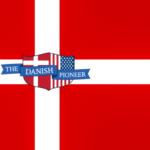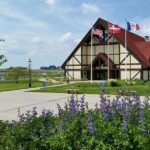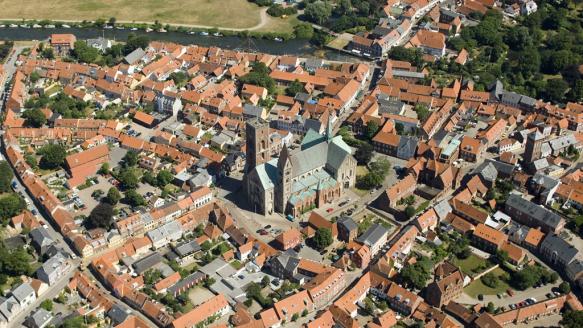
NEW COLUMN: Denmark’s Towns & Cities – Discover Ribe, Denmark’s Oldest Town
New Column in The Danish Pioneer Newspaper: DANISH NOOKS & CRANNIES: Its Towns and Cities – By Dick Andersen
Ribe: Denmark’s Oldest Town . . .
Almost from any angle by which you approach the southwestern coastal Jutland site of Ribe, you get a view of an enlarged village just under 10,000 in population. The sky punctuated by the soaring towers of its eclectic-architectural cathedral offer a welcome to strangers and locals alike. Although a modern city in many respects, it has not lost its charm as a typical centuries-old Danish town with circuitous lanes and a number of charming old half-timbered houses.
It has a personality as vibrant as today’s Reba McIntyre. The names may be spelled differently, but the similarity is in their outgoing charisma. The red tile roofs are as dazzling as the singer’s flaming locks. And both town and celebrity can sing about being a “Survivor.” After all, much of Ribe was consumed by a devastating fire in 1580, but the difference between the two is that one is definitely a Danish Viking while the other, unfortunately, is not. The Danish Ribe is a historic Scandinavian trading center that began long ago in the eighth century.
During Roman times, then Viking times, its trading intensified and its renown flourished throughout Europe. Today, visitors can amble about a replicated Viking estate and visit with its “Viking residents” who exhibit ancient ways by demonstrating their once useful crafts, modes of dress, and living activities. They can see the town’s 110 ancient registered buildings plus examples of architecture from various periods including the Danish style of the oldest Town Hall in the Kingdom.
Ansgar, born near Amiens, France, in 801, entered Ribe as a missionary in 860. He came as the Archbishop of Hamburg-Bremen, with the permission of the local Jutish king, Harald Klak. Ansgar had previously baptized the local monarch, and sought his authority to evangelize Denmark. Earlier a Swedish king, Björn, had invited Ansgar to his court at Hauge in 829. Ansgar spent six months preaching near the shores of Lake Mäleran, where a small congregation was established.
As Ansgar, the Archbishop of Hamburg-Bremen, eyed the un-evangelized lands to the north, he realized the Good News of Christ’s gospel needed to be shared with the pagan Vikings, and their growing progeny, thus he set forth. In fact, his see had been designated by Rome to bring Christianity to the Norsemen.
Growing up in the French countryside, little Ansgar was trained at Corbie Abbey. Charlemagne had begun the Christianization of Northern Germany sometime before that which resulted in Saxony rejecting its former heathen religious past to become a fertile area for Christian evangelists. That history enabled Ansgar eventually to succeed to the archepiscopal see of Hamburg-Bremen following an initial successful missionary venture with other monks into the Danish kingdom.
In Ansgar’s convoluted history and that of his evangelization of Denmark, together with other brothers, the Archbishop gained royal permission to enter the realm anew to begin missionary activities, establish churches and eventually a cathedral. The current cathedral was constructed between 1150 and 1175, long after the original structure was built and probably destroyed by a town fire. Ribe’s bishopric, nevertheless, was established by Ansgar.
But despite all of Ansgar’s efforts, the un-evangelized tribes rebelled and raided Hamburg leaving it in total ruins. Elsewhere in Denmark, the pagan Norsemen plundered churches and ended Christianity’s influence by terrorizing Christ’s believers through several civil conflicts.
But this is an essay about today’s Ribe. It is not only the oldest Danish town, but it has the oldest Danish hotel…named after Queen Dagmar, the consort of Valdemar I. Its structure is made of brick and constructed in 1581. With only 50 double rooms, it is not like staying at an enormous SAS hotel or a Hilton. Hallways are narrow, floors slope, and stairways lack speedier elevators, but it has not only Danish hyggelig, but a feeling of dwelling in someone’s nicely modernized yet exceptionally comfortable home that has not lost all its 17th century feel.
 By the way, the Hotel Dagmar is across the street from the cathedral apse, and nearby are some of the town’s intriguing museums. But it is the cathedral towers that penetrate the sky like rockets ready for send-off that draw most tourists. Largely Romanesque, the structure shows influences from other architectural styles, yet its interior when recently restored in 1983 gained a rather shocking contribution. Carl Henning Pedersen, one of the so-called COBRA artists, decorated the ceiling of the apse with contemporary fantasy figures in colorful frescoes, stained glass and mosaics. To me, his design is hideous, and does not compliment either the church’s architecture or its ecclesiastical purpose. However, that’s my antiquated opinion. Today’s Danes love that kind of relatively meaningless art, so I’m in the minority.
By the way, the Hotel Dagmar is across the street from the cathedral apse, and nearby are some of the town’s intriguing museums. But it is the cathedral towers that penetrate the sky like rockets ready for send-off that draw most tourists. Largely Romanesque, the structure shows influences from other architectural styles, yet its interior when recently restored in 1983 gained a rather shocking contribution. Carl Henning Pedersen, one of the so-called COBRA artists, decorated the ceiling of the apse with contemporary fantasy figures in colorful frescoes, stained glass and mosaics. To me, his design is hideous, and does not compliment either the church’s architecture or its ecclesiastical purpose. However, that’s my antiquated opinion. Today’s Danes love that kind of relatively meaningless art, so I’m in the minority.
While the cathedral was saved from the destruction caused by the Reformation, only St. Catherine’s Church and monastery remain from the many other churches once crowding the town. It is said to be one of the most beautiful preserved medieval structures in the region. Founded by Dominicans in the Middle Ages, it is constantly under repair and reconstruction, since the River Ribe flows too close and constantly erodes the underlying soil.
In the Middle Ages, the town was a royal favorite as a summer vacation spot. That’s the reason for the construction of Riberhus Castle nearby, which today is a mere ruin, having been destroyed by Swedish invaders in the 17th century.
One of the favorite factors of a summer visit to Ribe is the night watchman’s evening stroll through the curling lanes of the town, and another is a “ghost walk” that introduces guests to many tales about the storied village. The home of hymnwriter Hans Adolf Brorson, Ribe was also the birthplace of Jacob Riis, who became a famous American “muckraking” journalist and social reformer as well as a close friend to President Theodore Roosevelt. He was considered a pioneer in his use of photography. Unfortunately, according to his enticing biography, Ribe really never acknowledged him as one of their own despite the many honors he received and the international fame he achieved.
I hope you enjoyed this brief visit to Denmark’s oldest town and will include it in one of your visits to southwestern Jutland.
(Photos courtesy of VisitRibe. For more info on Ribe, see www.visitribe.com)
ABOUT THE DANISH PIONEER NEWSPAPER – SINCE 1872 – ENGLISH & DANISH ARTICLES
THE DANISH PIONEER NEWSPAPER IN ACTION: Did you know that The Danish Pioneer staff, editors, columnists and writers help readers discover unique travel destinations in Denmark & Scandinavia? Come discover more in 2014.
THE DANISH PIONEER NEWSPAPER WAS FOUNDED IN OMAHA, NEBRASKA IN 1872 AND TODAY IS STILL PUBLISHED JUST OUTSIDE CHICAGO, ILLINOIS. Did you know by supporting The Danish Pioneer Newspaper’s print edition, we are able to offer the bonus of our colorful, exciting website. Please support The Danish Pioneer Newspaper. Subscriptions to our print edition are economical, and you receive 26 issues per year including the extra-large, extra-special holiday issue. Subscriptions and advertisements – like annual donations to ethnic institutions or memberships to clubs, lodges and organizations – help The Danish Pioneer Newspaper staff to preserve and to support the Danish-American ethnic press in addition to allowing us to promote the Danish and Scandinavian culture, communities, heritage and traditions in the USA and North America. Please subscribe today or give The Danish Pioneer Newspaper as a gift subscription to a friend or relative. Visit http://www.thedanishpioneer.com/subscribe/
MANGE TAK! Thank you and WELCOME to The Danish Pioneer Family!









